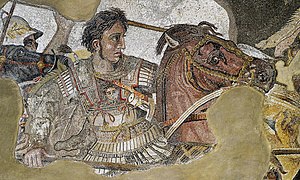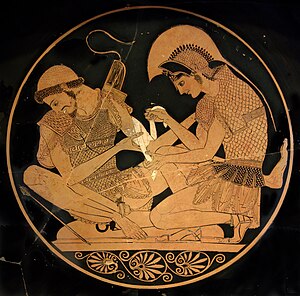λινοθώρηξ
Τραφὲν ὄρεσι καὶ φάραγξιν ἀγρίαις, κήρυξ πέφυκα τῆς λόγου ὑμνῳδίας. Φωνήν μὲν οὐκ ἔναρθρον, εὔηχον δ' ἔχω (Byzantine riddle) → Raised in the mountains and wild ravines, I have become the herald of hymns that are sung. I have no articulate voice...
English (LSJ)
Ep. and Ion. for λινοθώραξ.
German (Pape)
[Seite 49] ηκος, mit leinenem Harnisch, Il. 2, 529. 830; orac. bei Schol. Theocr. 14, 48.
French (Bailly abrégé)
ηκος (ὁ, ἡ)
à la cuirasse de lin.
Étymologie: λίνον, θώρηξ ion. p. θώραξ.
Russian (Dvoretsky)
λῐνοθώρηξ: ηκος adj. одетый в льняной панцырь Hom., Xen.
Greek (Liddell-Scott)
λῐνοθώρηξ: ηκος, ὁ, ἡ, Ἰων. ἀντὶ λινoθώραξ, ὁ φορῶν θώρακα ἐκ λίνου, Ἰλ. Β. 529, 830· ἐπὶ τῶν Περσῶν, Ξεν. Κύρ. 5. 4, 2.
English (Autenrieth)
with linen cuirass, Il. 2.529. (As represented in adjoining cut, No. 79; cf. also No. 12.)
Greek Monotonic
λῐνοθώρηξ: -ηκος, ὁ, ἡ, Αττ. λινοθώραξ, -ᾶκος, αυτός που φοράει λινό θώρακα, σε Ομήρ. Ιλ., Ξεν.
Middle Liddell
λῐνο-θώρηξ, ηκος, ὁ,
wearing a linen cuirass, Il., Xen.
Wikipedia EN

The linothorax (pronounced /ˈliːnoʊθɔːræks/) (Greek: λινοθώρακας) is a type of upper body armor used by the ancient Macedonians. The term linothorax is a modern term based on the Greek λινοθώραξ, which means "wearing a breastplate of linen", however the actual ancient term for this type of armor is unclear. The term "thorax" was the word for breastplate during this era and was traditionally made of metal in most contexts. The "linothorax" were made of linen glued in layers with animal fat, and eventually adopted by many armies.
The linothorax appears to have been used in place of the bronze "bell cuirass" as the popular choice of armor for Greek hoplites, starting perhaps around the late seventh century and early sixth century B.C. This could have been due to the lower price, lesser weight, and cooler material. Its high point in vase paintings, sculptural reliefs and artistic depictions corresponds with the time of the Persian Wars. By the time of the Peloponnesian War it was still used, and continued to seemingly flourish well into the Hellenistic period.
Wikipedia DE
Der Leinenpanzer, griechisch Linothorax, ist ein Brustpanzer auf Leinenbasis, der vor allem im Antiken Griechenland verwendet wurde. Er galt als so kostbar, dass er in den Tempeln als Weihegeschenk dargebracht wurde.
Wikipedia ES
El linotórax era un tipo de armadura usada por los antiguos griegos desde la época micénica hasta la clásica. El linotórax es mencionado por Homero en la Ilíada. El linotórax parece haber sido la armadura más popular entre finales del siglo VI a. C. y el siglo V a. C., desde la época de las guerras médicas hasta la guerra del Peloponeso. Sin embargo, se volvió popular otra vez gracias a las reformas del general ateniense Ifícrates a mediados del siglo IV a. C. y después en los ejércitos de Filipo II de Macedonia y su hijo Alejandro Magno. La disminución del uso del linotórax, alrededor del final del siglo III a. C., parece tener correlación con el aumento del empleo de la malla, o cota de malla.
Wikipedia FR
Linothorax est le nom donné à une famille de broignes et de jaques durant la Grèce antique. On le trouve parfois désigné sous le nom de corselet.
Wikipedia IT
La Linothorax (in greco antico: λινοθώραξ, in Omero λινοθώρηξ) era un tipo di armatura usata nell'antica Grecia dall'epoca micenea fino all'Ellenismo; se ne hanno testimonianze per più di mille anni, dalla guerra di Troia alle guerre di Alessandro Magno, fino al periodo dei Diadochi.
La prima testimonianza dell'uso di una linothorax si trova nell'Iliade di Omero, dove ci viene tramandato che questa protezione veniva indossata dal mitico Aiace Oileo. Plutarco ci testimonia che la linothorax fu utilizzata anche da Alessandro Magno e troviamo citazioni di questa armatura anche in Erodoto, Tito Livio, Strabone, e in altri autori.
Date queste fonti storiche, nonostante le ricostruzioni di armature metalliche visibili nei film riguardanti Alessandro, si ritiene che, con un'armatura in bronzo, il condottiero difficilmente sarebbe sopravvissuto alle numerose battaglie alle quali partecipò stando in prima linea, in quanto moderni esperimenti hanno dimostrato che più strati di lino sovrapposti forniscono una resistenza alla penetrazione delle frecce decisamente maggiore di quella offerta da una lamina di bronzo.
Wikipedia RU
Линоторакс (др.-греч. λινοθώραξ) — древнегреческий панцирь из льняной ткани. Также был известен и в других частях античного мира. Подобные панцири использовались вероятно ещё с микенского периода, а с конца VI века до н. э. они становятся стандартным доспехом гоплитов. По сравнению с бронзовыми панцирями линотораксы были легче, дешевле и в меньшей степени стесняли движения, давая при этом сравнимую степень защиты. Линотораксы использовались до III века до н. э., когда они были сменены кольчугами.

